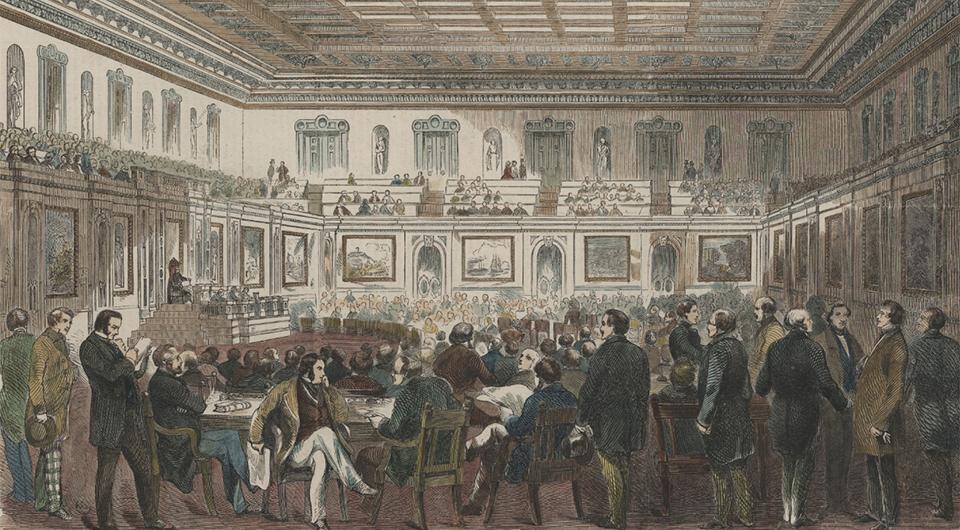About Publications Library Archives
heritagepost.org

Preserving Revolutionary & Civil War History

Preserving Revolutionary & Civil War History

When the Second Continental Congress convened in 1775, firebrands including Samuel Adams of Massachusetts and Patrick Henry of Virginia steered the 13 colonies of the United States toward a complete break with Great Britain. But that sentiment wasn’t universally shared a year earlier by members of the First Continental Congress. Grievances against British government policies were rife in the session which met in 1774, but some, notably Isaac Low of New York and Joseph Galloway of Pennsylvania, counseled against fully separating from the British Empire.
Low was a Brunswick, New Jersey-born merchant entrepreneur who helped to found the New York Chamber of Commerce. While he supported an economic boycott of British goods to nudge the English to the negotiating table, Low was hardly a revolutionary. He kept his business while living in British-occupied New York City.
Galloway, a Maryland native who moved northward at age 9, became a Philadelphia lawyer and member of Pennsylvania’s Provincial Assembly. Galloway believed in colonial autonomy, but under the protective cope of the British Empire. Galloway proffered a compromise along these lines, dubbed the “Plan of Union,” which envisioned a “Grand Council” of colonial representatives led by a “president general.” The council would manage colonial legislative affairs and have the power to veto acts of British Parliament. For a full day in September 1774, the Continental Congress weighed the merits of Galloway’s plan but eventually voted to table it, with six colonies voting against, five for.
Neither Low nor Galloway served in the Second Continental Congress and, in choosing to remain loyal to Great Britain throughout the war, shared in the fate of many colonial loyalists.
Loyalists’ status within the colonies remained extremely dubious during the revolution. Because the Continental and Confederation Congresses left the loyalists’ fate to local authorities, their treatment varied greatly. Some were driven into exile by local confiscation (or destruction) of their property. Others’ lives were threatened and a few barely escaped the wrath of lynch mobs.
Galloway continued to offer his “Plan of Union” in self-published manifestos, but joined the British Army in December 1776, where he served as an intelligence officer. Local authorities seized Galloway’s assets and forced the family to flee to Great Britain in 1778. A prominent exile, he served as an emissary between displaced loyalists and the British government. Until his death in 1803, Galloway promoted reconciliation between the young U.S. republic and Great Britain.
The terms of the Treaty of Paris of 1783 which concluded the Revolutionary War, obliged the Confederation Congress to “earnestly recommend . . . to the Legislatures of the respective States to provide for the Restitution of all Estates, Rights, and Properties” of loyalists, along with “the Estates, Rights, and Properties of Persons resident in Districts in the Possession on his Majesty’s Arms and who have not borne Arms against the said United States.” Loyalists received 12 months to seek compensation for their lost property.
But obstacles such as the limited time frame for seeking restitution and the embittered feelings between loyalist and rebel combatants convinced tens of thousands of loyalists to evacuate—with the aid of the British Navy—to other parts of the British Empire such as Canada, India, South Africa, and the West Indies. Low’s experience was typical in this regard. Years before the war ended, New York rebels had confiscated his Hudson Valley estate, and banished him for life. Low was evacuated from Manhattan when the British departed in 1783. He settled in Great Britain, receiving partial compensation for his losses, before dying in relative obscurity in 1791 on the Isle of Wight.
Sources: Maya Jasanoff, Liberty’s Exiles: American Loyalists in the Revolutionary World (New York: Vintage, 2012): 4, 23–36, 77–81, 130–138; Edward Countryman, “Low, Isaac,” American National Biography (ANB) 14 (New York: Oxford University Press, 1999): 26; Frank Baker, “Galloway, Joseph,” ANB 8 (New York: Oxford University Press, 1999): 657–658; “Transcript of the Treaty of Paris of 1783,” Our Documents, www.ourdocuments.gov (accessed 13 June 2013).